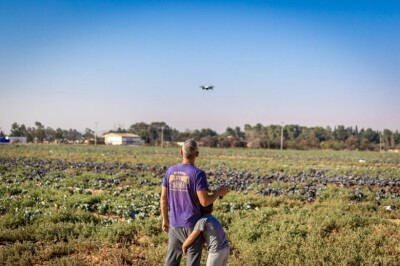Day 2 of AUVSI’s XPONENTIAL event saw the opening of the show floor, where over 600 exhibitors showcased the latest in unmanned technology for various industries. On Day 1, we were able to hear what sort of challenges regulators are dealing with while also finding out how things are changing for miners and farmers. On Day 2, we got a much wider perspective of how things are playing out for the industry as a whole and for enterprise customers, but also took a look at some developments in search and rescue and in oil and gas.
Keep checking back with us for more updates from XPONENTIAL.
Brian Wynne

John Chambers
 Drones in Enterprise: The Sky’s the Limit was moderated by Jesse Kallman and featured Alex Tepper, Matt Walsh, Kevin Grover and Todd Binion, who are all working at the enterprise level and looking to incorporate drones into their operations in one way or another. The group individually discussed where things are in their organizations as, for example, insurance companies are looking to drones to deploy for help assessing hurricane damage and even roof inspections. All of them laid out the challenges they’re dealing with as they relate to regulation and logistics.Once again, the audience had some specific questions to talk through with the group, as people wanted to ask about what sort of opportunities they’ve been able to enable at the enterprise level, and how they see such things changing and developing. Most of the group identified the fact that adoption will only be pursued when big companies can see the value in the data, and that there are currently some serious challenges as they relate to whether or not manufactures can provide solutions at scale. Being able to do so will be the only way we’ll be able to see the “fleets” of drones that will be able to perform a variety of tasks for these organizations.The panel ended with a question Kallman said he has brought up before, where he asked the panel what was the one thing they would change to FAA regulation if they could. Their answers ranged from the practical to the ambitious.
Drones in Enterprise: The Sky’s the Limit was moderated by Jesse Kallman and featured Alex Tepper, Matt Walsh, Kevin Grover and Todd Binion, who are all working at the enterprise level and looking to incorporate drones into their operations in one way or another. The group individually discussed where things are in their organizations as, for example, insurance companies are looking to drones to deploy for help assessing hurricane damage and even roof inspections. All of them laid out the challenges they’re dealing with as they relate to regulation and logistics.Once again, the audience had some specific questions to talk through with the group, as people wanted to ask about what sort of opportunities they’ve been able to enable at the enterprise level, and how they see such things changing and developing. Most of the group identified the fact that adoption will only be pursued when big companies can see the value in the data, and that there are currently some serious challenges as they relate to whether or not manufactures can provide solutions at scale. Being able to do so will be the only way we’ll be able to see the “fleets” of drones that will be able to perform a variety of tasks for these organizations.The panel ended with a question Kallman said he has brought up before, where he asked the panel what was the one thing they would change to FAA regulation if they could. Their answers ranged from the practical to the ambitious. Joe Talley spoke at the First Responder Unmanned Autonomous Systems – Establishing an Agency’s UAV Team for Emergency Response session where his focus was on sharing info and ensuring that the audience was able to connect with one another. He discussed what is an emerging industry with various application in search and rescue, tactical response, traffic and plenty more.One of the more interesting bits of info he discussed was when he showed how UAVs can be used to track a missing firearm in the time period after it has been fired. Using a thermal camera, officials were able to search for and locate the weapon.Questions around regulation dominated the Q&A portion of the session, and while he talked through where things stand and offered specific advice, he also mentioned how important it is to understand the environment, and professionals need to focus on developing a solution with that environment in mind.
Joe Talley spoke at the First Responder Unmanned Autonomous Systems – Establishing an Agency’s UAV Team for Emergency Response session where his focus was on sharing info and ensuring that the audience was able to connect with one another. He discussed what is an emerging industry with various application in search and rescue, tactical response, traffic and plenty more.One of the more interesting bits of info he discussed was when he showed how UAVs can be used to track a missing firearm in the time period after it has been fired. Using a thermal camera, officials were able to search for and locate the weapon.Questions around regulation dominated the Q&A portion of the session, and while he talked through where things stand and offered specific advice, he also mentioned how important it is to understand the environment, and professionals need to focus on developing a solution with that environment in mind. Drones in the Field: Business Cases for the Agriculture Industry was a true collection of the top names in the field, as Chad Colby was joined by Baptiste Tripard, Brad Anderson, Nolan Berg and Tom McKinnon to discuss how unmanned aircraft has changed the way farmers manage their operations. The group discussed how the business side of farming has changed and how it’s gotten especially sophisticated. They also got specific around the benefits they’re seeing from using unmanned systems, which includes increased yields, reduced input costs and a high ROI.Colby mentioned that safely operating in the NAS was the biggest challenge right now, but also that some people struggle to change as things move so quickly. The group clearly believes in the technology and addressed specific instances where they’ve seen benefits, as well as a future of farming where everything is connected.
Drones in the Field: Business Cases for the Agriculture Industry was a true collection of the top names in the field, as Chad Colby was joined by Baptiste Tripard, Brad Anderson, Nolan Berg and Tom McKinnon to discuss how unmanned aircraft has changed the way farmers manage their operations. The group discussed how the business side of farming has changed and how it’s gotten especially sophisticated. They also got specific around the benefits they’re seeing from using unmanned systems, which includes increased yields, reduced input costs and a high ROI.Colby mentioned that safely operating in the NAS was the biggest challenge right now, but also that some people struggle to change as things move so quickly. The group clearly believes in the technology and addressed specific instances where they’ve seen benefits, as well as a future of farming where everything is connected. Todd Chase spoke at the Management of UAS Operations within the Oil and Gas Industry, and he admitted he had originally wanted to call the session something along the lines of “I bought a drone, how do I get an oil and gas contract?” As the Global UAS Program Manager for Oceaneering-GDS, Chase is particularly qualified to discuss such things, and he laid out how and why owning a drone might be the least important part of securing this kind of work.He talked through how oil and gas companies have recognized what a valuable tools drones can be, but having process management systems is essential. It’s really not about a drone, but about the people, training, equipment, procedures and experience. Drones need to be “fit for purpose”, and he stressed how and why the standards that companies have are so important.
Todd Chase spoke at the Management of UAS Operations within the Oil and Gas Industry, and he admitted he had originally wanted to call the session something along the lines of “I bought a drone, how do I get an oil and gas contract?” As the Global UAS Program Manager for Oceaneering-GDS, Chase is particularly qualified to discuss such things, and he laid out how and why owning a drone might be the least important part of securing this kind of work.He talked through how oil and gas companies have recognized what a valuable tools drones can be, but having process management systems is essential. It’s really not about a drone, but about the people, training, equipment, procedures and experience. Drones need to be “fit for purpose”, and he stressed how and why the standards that companies have are so important. The educational tracks at the event are obviously top notch, while the show floor featured various vendors who are at the event to show off their drones and UAVs. The breadth and scope of organizations that are at the event is pretty amazing to see. Companies that do everything from manufacture specific parts to entire systems are here, and they range from being all-purpose machines to tools that a built for a single purpose.While it’s great to be able to hear from such experts like Colby and Chase, the ability to connect with them is what really makes the even special, and discussion groups were setup to enable just that. The sections of the show floor that are set aside for presentations also gave attendees a chance to check out some of the expertise that was on display without having to trek to the sessions.
The educational tracks at the event are obviously top notch, while the show floor featured various vendors who are at the event to show off their drones and UAVs. The breadth and scope of organizations that are at the event is pretty amazing to see. Companies that do everything from manufacture specific parts to entire systems are here, and they range from being all-purpose machines to tools that a built for a single purpose.While it’s great to be able to hear from such experts like Colby and Chase, the ability to connect with them is what really makes the even special, and discussion groups were setup to enable just that. The sections of the show floor that are set aside for presentations also gave attendees a chance to check out some of the expertise that was on display without having to trek to the sessions.
 Stay tuned for more coverage from AUVSI, and let us know your thoughts around the event.
Stay tuned for more coverage from AUVSI, and let us know your thoughts around the event. 














Comments